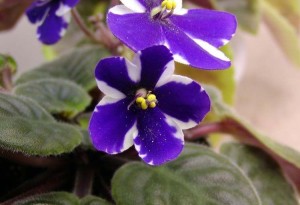Insects that damage the African violet: Trips-ul (Thripidae).
 Thrips is one of the most widespread pests of decorative plants and agricultural crops. Probable, there is no plant in the world that has not been attacked by these insects.
Thrips is one of the most widespread pests of decorative plants and agricultural crops. Probable, there is no plant in the world that has not been attacked by these insects.
In greenhouse conditions, it is impossible to completely destroy the thrips. Their number should be kept under control so that the insects in question damage the decorative appearance and quality of the plants as little as possible., its fruits Vegetables.
Those who intend to collect Saintpaulia, must be prepared to get acquainted with the representatives of this species as well. In apartment conditions, it can totally get rid of these little creatures.
But we have to know who we are dealing with.
Thrips are very small insects, the length of adult insects is 2-2.5 mm, and the thickness of the body is not more than 1 mm. It is "equipped" with two pairs of wings. At rest, the wings are bent in the form of a narrow and bright stripe on the back of the insect and are invisible.
Mature insects are darker in color – black or brown. The larvae of many species of thrips are lighter in color – yellow or boars, this fact allows them to be hardly distinguished on the surface of the leaf and plant. Larvae differ from adults by body size, that's much smaller and they lack the wings.
Detecting thrips is quite difficult. These insects lead a more isolated way of life, hiding in the stamens, flower buds or even in the axillary points of the leaves.
The graph of combating thrips should be designed according to the stages of development of the insect. The insect has 6 stages of development :
•Egg. The female lays her eggs in the tissues of the leaves and flowers. The chemical processing of the plant during the egg deposits destroys everything that moves and feeds, less eggs;
• stage I larva, II and adult present on the leaves, Branches, flowers and fruits in development ;
• stage I and II pupa in soil. In stage II of development of thrips is protected from the effect of chemicals. The larva ceases to feed and buries itself in the soil at the roots of the plant, chemicals no longer having any effect on the larva.
Thrips are resistant to pesticides, especially insects on the surface of the plant. They grow and multiply rapidly, and to combat them usually proceeds to increase the concentration of insecticides, 2-3 times higher than the recommended dose.
The first sign indicating the presence of thrips on the surface the plant is the sticky pollen that falls from the stamens on the petals of the flowers. It should also be borne in mind that pollen can be present on the petals of the flowers during the heat, of changing the place of the plant, shaking flowers or contamination of the plant with certain species of mites.
the plant is the sticky pollen that falls from the stamens on the petals of the flowers. It should also be borne in mind that pollen can be present on the petals of the flowers during the heat, of changing the place of the plant, shaking flowers or contamination of the plant with certain species of mites.
To check if the plant is affected by thrips, will break a few flowers and shake several times or finger over a sheet of black paper. You can also open a few anthers.
The damage and the degree of damage to Saintpaulia depends very much on the species of thrips.
The greenhouse trips (Californian), tobacco and decorative plants feed not only in the area of flowers, but also on the surface of the leaves, causing damage similar to those produced by the flat mite, but being much more severe and leaving on the surface of the leaf a lot of sucking cells arranged in stripes. With time, thrips greatly affect the decorative appearance of violet. Flowers become semiophilic, deformed and stained with small dots of white and black color (alba- Musculitis, Black- feces). The leaves have an unsightly appearance, the parka would have been stung with a lot of needles. Abundant pollen is sprinkled on the lower petals of the flowers.
There are also species of less aggressive thrips, that give life to only one generation per year. Usually, they enter the apartments through the open windows, vents, bouquets of flowers. Behaves "peacefully", "produce" pollen in small quantities and insignificantly diminish the flowering period. With the beginning of autumn can be observed even a self-treatment of the plant. The trips as if they had entered the ground. But the situation is far from real. Some species of thrips find a pleasant place for hibernation.
The most aggressive species of thrips for African violets are the Californian thrips, the greenhouse thrips, tobacco thrips. These guys do not leave the plant in any case. Plants are damaged in an aggressive way, flowers become unsightly. They are carriers of viral infections, hard-borne plant.
The only way to get rid of thrips is to carry out a series of treatments with systemic insecticides (ACTARA, CONFIDOR, DIAZOL, DIMETHOX, FASTAC, LEADER700 WG, MALATOX, MOSPILAN, etc.). Quite effective it turns out to be a 2-3 times increased concentration of insecticide plus a small amount of zoosampon (against fleas). At the time of chemical processing, the flower buds will be removed. It is recommended 2-3 processing at an interval of 10 days.

